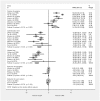Holmium laser enucleation versus transurethral resection in patients with benign prostate hyperplasia: an updated systematic review with meta-analysis and trial sequential analysis
- PMID: 25003963
- PMCID: PMC4086899
- DOI: 10.1371/journal.pone.0101615
Holmium laser enucleation versus transurethral resection in patients with benign prostate hyperplasia: an updated systematic review with meta-analysis and trial sequential analysis
Abstract
Background: Holmium laser enucleation (HoLEP) in surgical treatment of benign prostate hyperplasia (BPH) potentially offers advantages over transurethral resection of the prostate (TURP).
Methods: Published randomized controlled trials (RCTs) were identified from PubMed, EMBASE, Science Citation Index, and the Cochrane Library up to October 10, 2013 (updated on February 5, 2014). After methodological quality assessment and data extraction, meta-analysis was performed using STATA 12.0 and Trial Sequential Analysis (TSA) 0.9 software.
Results: Fifteen studies including 8 RCTs involving 855 patients met the criteria. The results of meta-analysis showed that: a) efficacy indicators: there was no significant difference in quality of life between the two groups (P>0.05), but compared with the TURP group, Qmax was better at 3 months and 12 months, PVR was less at 6, 12 months, and IPSS was lower at 12 months in the HoLEP, b) safety indicators: compared with the TURP, HoLEP had less blood transfusion (RR 0.17, 95% CI 0.06 to 0.47), but there was no significant difference in early and late postoperative complications (P>0.05), and c) perioperative indicators: HoLEP was associated with longer operation time (WMD 14.19 min, 95% CI 6.30 to 22.08 min), shorter catheterization time (WMD -19.97 h, 95% CI -24.24 to -15.70 h) and hospital stay (WMD -25.25 h, 95% CI -29.81 to -20.68 h).
Conclusions: In conventional meta-analyses, there is no clinically relevant difference in early and late postoperative complications between the two techniques, but HoLEP is preferable due to advantage in the curative effect, less blood transfusion rate, shorter catheterization duration time and hospital stay. However, trial sequential analysis does not allow us to draw any solid conclusion in overall clinical benefit comparison between the two approaches. Further large, well-designed, multicentre/international RCTs with long-term data and the comparison between the two approaches remain open.
Conflict of interest statement
Figures











References
-
- McVary KT, Roehrborn CG, Avins AL, Barry MJ, Bruskewitz RC, et al. (2011) Update on AUA guideline on the management of benign prostatic hyperplasia. J Urol 185: 1793–1803. - PubMed
-
- Oelke M, Bachmann A, Descazeaud A, Emberton M, Gravas S, et al. (2013) EAU guidelines on the treatment and follow-up of non-neurogenic male lower urinary tract symptoms including benign prostatic obstruction. Eur Urol 64: 118–140. - PubMed
-
- Gilling P, Fraundorfer M, Kabalin J (1997) Holmium: YAG laser resection of the prostate (HoLRP) versus transurethral electrocautery resection of the prostate (TURP): a prospective randomized, urodynamics-based clinical trial. J Urol 157: 149A.
-
- Gilling PJ, Aho TF, Frampton CM, King CJ, Fraundorfer MR (2008) Holmium laser enucleation of the prostate: results at 6 years. Eur Urol 53: 744–749. - PubMed
-
- Kabalin JN, Mackey MJ, Cresswell MD, Fraundorfer MR, Gilling PJ (1997) Holmium: YAG laser resection of prostate (HoLRP) for patients in urinary retention. J Endourol 11: 291–293. - PubMed
Publication types
MeSH terms
LinkOut - more resources
Full Text Sources
Other Literature Sources
Medical
Research Materials
Miscellaneous

